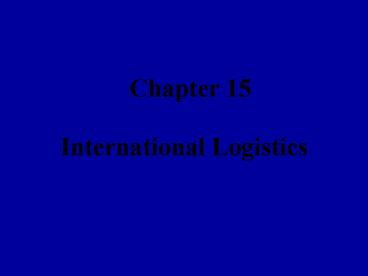International Logistics - PowerPoint PPT Presentation
1 / 13
Title:
International Logistics
Description:
Roads, rail lines, airports, seaports, pipelines. Availability of transportation modes ... carrier (truck, rail, inland carrier carrier, in or ocean ... – PowerPoint PPT presentation
Number of Views:306
Avg rating:3.0/5.0
Title: International Logistics
1
Chapter 15
International Logistics
2
International Logistics
- I. International Logistics - the designing and
managing of a system that controls the flow of
materials into, through, and out of the
international corporation. - Major decision areas
- locating plants and warehouses choice of
transportation mode managing inventory
packaging.
3
The Impact of International Logistics
- Logistical costs are 10 to 30 of the total
landed cost of an international order. - Factors necessary for the use of logistics as a
competitive tool - Close collaboration with suppliers and customers
- Technologically advanced information processing
and communication exchange capabilities - An integrated business infrastructure
4
International Transportation Issues
- Transportation infrastructure
- Roads, rail lines, airports, seaports, pipelines
- Availability of transportation modes
- Overland shipping, ocean shipping, air shipping
- Choice of modes
- Transit time, predictability, cost, noneconomic
factors - Noneconomic Factors
- Government involvement, the UNCTAD and the
40/40/20 concept
5
International Logistics
- II. Inventory Management Considerations
- - Carrying costs
- - Order cycle time
- - Order cycle consistency
- - Difficulty in applying service rules
6
International Inventory Issues
- Inventory carrying costs can be up to 25 of the
value of an inventory - Just-in-Time policies minimize inventory volume
by making it available when needed. - Inventories assist in the movement of products.
- Factors in deciding on the level of inventory to
maintain - Order cycle time
- Desired level of customer service
- Use of Inventory as a strategic tool
7
Order Cycle Time
- The total time that passes between the placement
of an order and the receipt of the merchandise. - Length of the total order cycle
- Longer cycle in international marketing than
domestic - Consistency of the order cycle
- More complicated delivery mode reduces
consistency - Altering cycle times
- Change transportation methods
- Change inventory locations
- Change ordering process
8
International Logistics
- III. Packaging Issues
- 1) Responsibility of the shipper
- 2) Climate
- 3) Shape and weight
- 4) Environment
- IV. Methods of Payment
9
Getting PaidForeign Commercial Payments
- Letters of Credit
- - Revocable
- - Irrevocable
- Cash in advance
- Open Accounts
- Forfaiting
10
Whos Responsible for Costs Under Various Terms?
FOB (Free on FOB (Free on FAS (Free CIF
(Cost Board) Inland Board) Inland Along
Side) Insurance, Carrier at Carrier at Vessel
or Freight) at Factory Points of Plane at
Port Port of Shipment of Shipment Destination
Export packing Buyer Seller Seller Seller Inlan
d freight Buyer Seller Seller Seller Port
charges Buyer Buyer Seller Seller Forwarder's
fee Buyer Buyer Buyer Seller Consular fee
Buyer Buyer Buyer Buyer Loading on vessel
orplane Buyer Buyer Buyer Seller Ocean
freight Buyer Buyer Buyer Seller Cargo
insurance Buyer Buyer Buyer Seller Customs
duties Buyer Buyer Buyer Buyer Ownership of
When goods on When goods When goods When
goods goods passes board an inland unloaded
by alongside on board air carrier (truck,
rail, inland carrier carrier, in or
ocean etc.) or in hands hands of air carrier
at port of inland carrier or ocean carrier of
shipment
15-15
Who absorbs export packing? This charge should
be clearly agreed on. Charges are sometimes
controversial. The seller has responsibility
to arrange for consular invoices (and other
documents requested by buyer's government).
According to official definitions, buyer pays
fees, but sometimes as a matter of practice,
seller included in quotations.
Irwin/McGraw-Hill
11
The Exporting Process
Leaving the Exporting Country
Physical Distribution
Entering the Importing Country
LicensesGeneralValidated DocumentationExport
declarationCommercial invoiceBill of
ladingConsular invoiceSpecial
certificatesOther documents
International shipping and logistics Packing Insu
rance
Tariffs, Taxes Non-tariff Barriers Standards Ins
pection Documentation Quotas Fees Licenses Sp
ecial certificates Exchange permits Other
barriers
15-3
Irwin/McGraw-Hill
12
Export Administration Regulations (EAR)
- A new country and commodity classification system
has been devised, making it the exporters
responsibility to select the proper
classification number for an item to be exported. - The exporter must decide if there are end-use
restrictions on the items, such as their possible
use in the development of nuclear, chemical, and
biological weapons. - The exporter now has the responsibility to
determine the ultimate end customer and ultimate
end uses, regardless of who may be the initial
buyer, or face the legal consequences of doing
business with unauthorized trading partners. - A special category for the control of
encryption-related products has been established.
15-4
Irwin/McGraw-Hill
13
(No Transcript)































